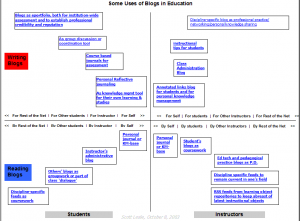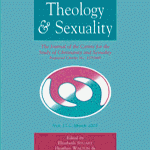Okay, I have been watching way too much Brady Bunch this summer. I still have the theme song going through my head. Here’s a story…of a troublemaker…who was writing ’bout her troublemaking past… Anyway, a few days ago I wrote an entry about kids-as-disciplinary-problems, Judith Butler, and troublemaking. It got me thinking about my own narrative of growing up as a troublemaker.
As a child, I was a troublemaker. But, what does that mean? Well, I had a lot of teachers who really didn’t like me (from elementary school through high school). Not because I acted out in class. I didn’t. Not because I made faces in assemblies. I didn’t. And not because I “did really bad things.” Because, I really didn’t. No, they disliked me because they could sense—somehow—that I saw through their bullshit (for more on being a bullshit detector, see here) and that I wasn’t going to simply believe that what they said was the “Truth.” I guess I was a threat to their already tenuous hold on the classroom.
I asked a lot of questions (and not hostile ones. Just lots and lots of “why” questions). I always wanted to know why things worked the way that they did. I liked exploring ideas without immediately placing judgment on them. And even though I looked the part of the good little white student, I refused to fully buy into the rules and norms that undergird the white suburban school and its goal of molding the minds of children into good little consumer citizens.
So, when I think of my own troublemaking “roots” it is not through the tradition of disrupting class or being disrespectful to teachers. For me, troublemaking was never about breaking the rules (even though I can see why many rules need to be broken) or rebelling against authority/authority figures. No, the tradition of troublemaking that I draw upon in my own understanding and practice of being in/making/staying in trouble is the tradition of posing questions…and lots of them. The question that I used to pose a lot as a kid, and the question that Butler suggests is the first act of disobedience, is “why.” As in, why is something this way and not that? For Butler, to ask “why” is to introduce the possibility that something could be otherwise, that the way things are is not they only way that should or could be. It is to open up the possibility of making ourselves into subjects-who-disobey instead of subjects-who-merely-obey. [Of course, “why” is not the only question many of us do—or should—ask. With my training in feminist/queer/critical theory, the question that I pose a lot now is “at whose expense”? This question seems to infuse the somewhat innocent “why” with an awareness of oppression and a desire for justice.]
Here are some key passages from my earlier entry on Butler and asking lots of questions:
Butler argues that asking why things are the way that they are is a form of disobedience (or is way of not being obedient if obedience requires unquestioned acceptance). The emphasis here is not on disobedience as a refusal to follow the rules or a rejection of rules altogether–some rules are necessary and important and helpful. No, Butler wants to emphasize disobedience as the refusal to be/become subjects who accept and willingly/unthinkingly obey the dictates that we are given without question. Again, in this sense, the disobedience is not to Rules or Law or the State (although that is important as well), but to the formation of us as subjects-who-merely-obey. So, Butler is particularly interested in how our obedience or disobedience functions on the level of self-(re)making (or what Butler would call subject formation).
Now, this idea of disobedience is not just about how and who we are as political subjects who engage in those practices that are traditionally considered to be political (like voting or protesting or being a part of activist communities or even participating in civic organizations). This idea of disobedience is about how and who we are as selves as we engage in our everyday activities and as we work (intentionally and not so intentionally) on our moral/ethical/intellectual development. And it happens when we ask “why”–not once or twice but everyday and all the time.
In this earlier entry, I link Butler’s promotion of asking questions with the “childish” behavior of asking “why”:
Kids are really good (sometimes too good) at asking “why”–from the mundane (why isn’t yellow your favorite color?) to the scientific (why can’t it snow in the summer?) to the existential (why can’t Nana live forever?) to the defiant (why do I have to eat my vegetables?) to the disturbing (why can’t I eat my own poop?) to the repetitive (Why? Why? Why?). The asking of these questions can be tedious for parents, but they are (most often) not done by children in order to be destructive or disrespectful. At their best, these “why” questions demonstrate curiosity and an interest in (caring about) the world and how it works. And, they are an assertion of a self-in-process who is claiming their independence from the forces that shape them.
Posing “why” and later, “at whose expense” questions (to myself and to others) got me in a lot of trouble. A lot of that trouble was bad (such as teachers hating me, being dismissed and discounted as a problem—not so much a disciplinary problem but just a problem), but a lot more of it was good (as in helpful/productive/motivating for me). The refusal to merely accept and the desire to remain open to other ways of being (instead of just fixing in on the way I am supposed to see and/or act in the world) shaped who I am and have, I think, made me a better (happier, more responsible, aware and just) person.
I am drawn to Judith Butler’s work because one primary aspect of her philosophy/ethos/system of thought is the value of asking (and never stopping your asking) of questions. When I look to Butler it is this important strain in her work that resonates with me. Not the acting out (and acting up) that is reflected in the narrative about her as a “disciplinary problem.” This single-minded reduction of troublemaking to bad behavior and the revaluing of “being bad” as good doesn’t work for me. It certainly doesn’t speak to my experiences. And, it is not, in my opinion, a helpful resource for a feminist or queer ethics.
Butler’s emphasis on always asking questions helped me to understand what I had been doing for so long when I was younger. When I was a kid I felt the pressure of opposing forces: 1. a family of intellectuals who encouraged me to think and question and challenge and care (about justice, from my dad the ethicist, and about the world and imagining it otherwise, from my mother, the artist/dreamer/social historian) and 2. the (almost completely) white suburban, conformity-imposing, competition-driven public schools that I attended from fifth through twelfth grade. From my family (and my position as white and middle/intellectual-class), I inherited a strong sense of entitlement–of course, I should ask questions and think, I could do anything and be anything! But from the schools I attended in suburban D.C. (in Northern Virginia) and suburban Des Moines (the insurance capital of the Midwest!), I was reminded everyday that I could ask some questions but only if they were framed in the right way and only if they furthered the goals of success in the forms of being better than everyone else and of acquiring the most stuff (status, possessions, awards, knowledge-as-commodity).
It has always been a struggle to navigate these forces. Why did I have to make everything so difficult? I would sometimes ask myself. Why can’t I just participate in the system like a “good girl”? [Of course, as a white, middle-class, heterosexual, I was a “good” and proper girl and my choice to not fit in was always just that…a choice. I always had the privilege to pass and fit in as normal, even if I often felt like I couldn’t force myself to do it.] How can I reconcile the desire to care about others/the world/justice that my parents instilled in me with the implicit (and sometimes explicit) command by many teachers/adults/”society” to care only about myself and how I could fit in and be very successful? Of course, this was definitely not how I phrased it as a child. But the language of feminist and queer theories and of Butler’s (albeit underdeveloped) notion of troublemaking have given me a way in which to understand and articulate what was (at least partially) going on with my struggles to care but fit in, to question but not to outrage or alienate, and to stay open to new possibilities of thinking, being and doing.
So, there you have it. The opening chapter (or maybe the preface) to my troublemaking narrative. There is much more to say about my own experiences of making/staying in trouble. Indeed, I feel like I have barely scratched the surface.


